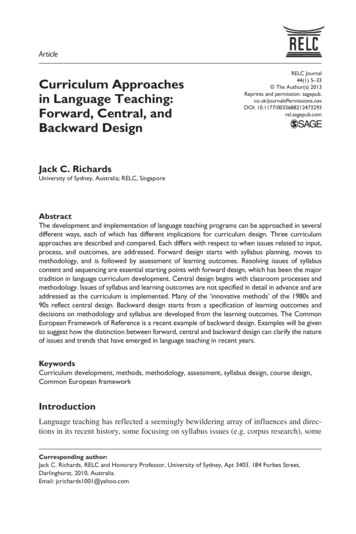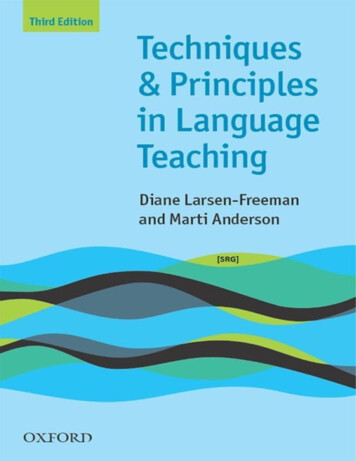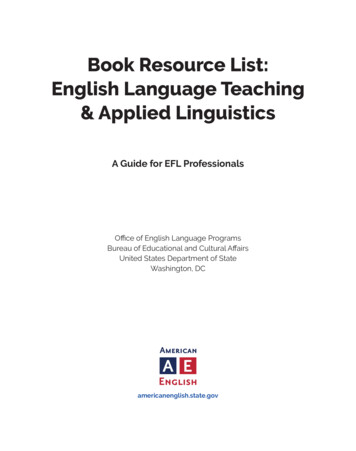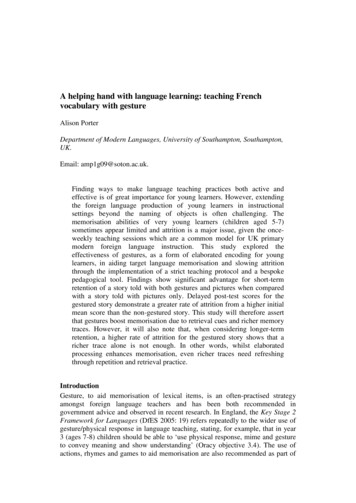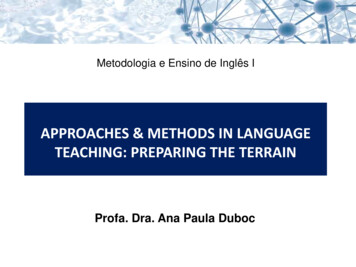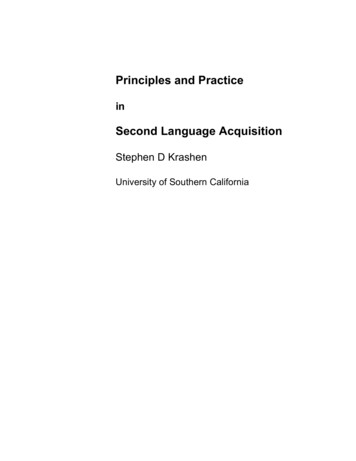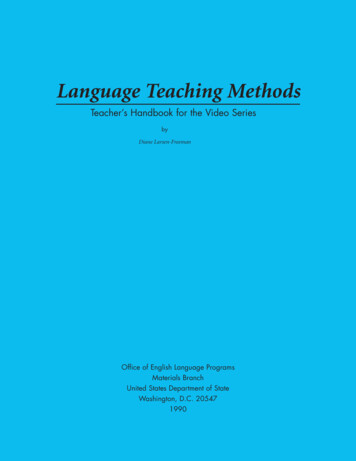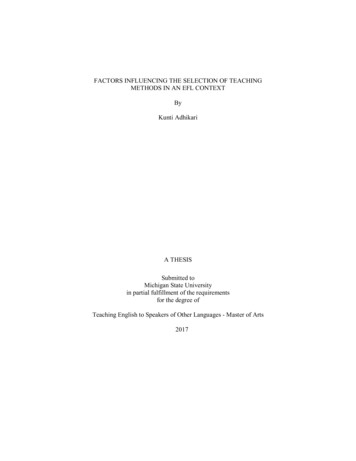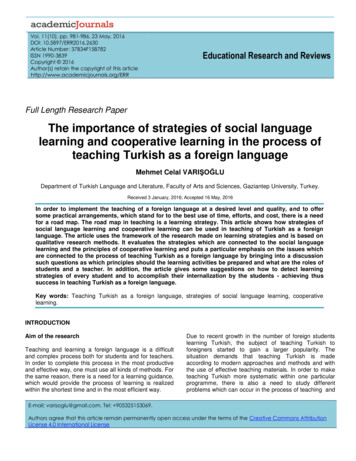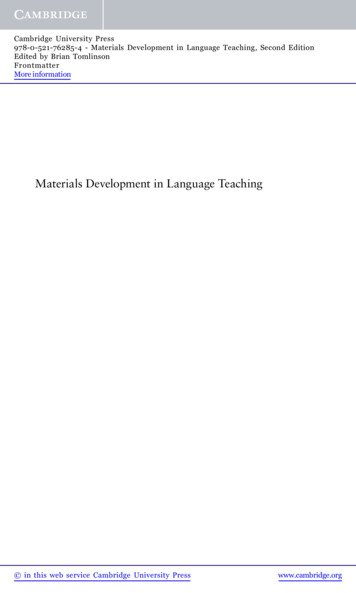
Transcription
Cambridge University Press978-0-521-76285-4 - Materials Development in Language Teaching, Second EditionEdited by Brian TomlinsonFrontmatterMore informationMaterials Development in Language Teaching in this web service Cambridge University Presswww.cambridge.org
Cambridge University Press978-0-521-76285-4 - Materials Development in Language Teaching, Second EditionEdited by Brian TomlinsonFrontmatterMore informationCAMBRIDGE LANGUAGE TEACHING LIBR ARYA series covering central issues in language teaching and learning,by authors who have expert knowledge in their field.For a complete list of titles please visit: www.cambridge.org/elt/cltlA selection of recent titles in this seriesMaterials Development in Language Teaching(Second Edition)Testing for Language Teachers(Second Edition)Edited by Brian TomlinsonArthur HughesValues, Philosophies, and Beliefs in TESOLMaking a StatementMotivational Strategies in the LanguageClassroomGraham CrookesZoltán DörnyeiListening in the Language ClassroomThe Dynamics of the Language ClassroomJohn FieldIan TudorLessons from Good Language LearnersUsing Surveys in Language ProgramsEdited by Carol GriffithsJames Dean BrownTeacher Language AwarenessApproaches and Methods in LanguageTeaching (Second Edition)Stephen AndrewsLanguage Teacher SupervisionA Case-Based ApproachJack C. Richards and Theodore S. RodgersKathleen M. BaileyLynne CameronConversationFrom Description to PedagogyClassroom Decision MakingNegotiation and Process Syllabuses in PracticeScott Thornbury and Diana SladeMichael P. Breen and Andrew LittlejohnThe Experience of Language TeachingEstablishing Self-AccessFrom Theory to PracticeRose SeniorLearners’ StoriesDifference and Diversity in Language LearningTeaching Languages to Young LearnersDavid Gardner and Lindsay MillerEdited by Phil Benson and David NunanCollaborative Action Research for EnglishLanguage TeachersTask-Based Language TeachingAnne BurnsDavid NunanAffect in Language LearningRules, Patterns and WordsGrammar and Lexis in English LanguageTeachingEdited by Jane ArnoldDave WillisDevelopments in English for SpecificPurposesA Multi-Disciplinary ApproachLanguage Learning in Distance EducationTony Dudley-Evans and Maggie Jo St JohnCynthia WhiteGroup Dynamics in the Language ClassroomLanguage Learning in Intercultural PerspectiveApproaches through Drama and EthnographyZoltán Dörnyei and Tim MurpheyEdited by Michael Byram and Michael Fleming in this web service Cambridge University Presswww.cambridge.org
Cambridge University Press978-0-521-76285-4 - Materials Development in Language Teaching, Second EditionEdited by Brian TomlinsonFrontmatterMore informationMaterials Developmentin Language TeachingSecond EditionEdited byBrian Tomlinson in this web service Cambridge University Presswww.cambridge.org
Cambridge University Press978-0-521-76285-4 - Materials Development in Language Teaching, Second EditionEdited by Brian TomlinsonFrontmatterMore informationcambridge university pressCambridge, New York, Melbourne, Madrid, Cape Town,Singapore, São Paulo, Delhi, Tokyo, Mexico CityCambridge University PressThe Edinburgh Building, Cambridge cb2 8ru, UKwww.cambridge.orgInformation on this title: www.cambridge.org/9780521157049 Cambridge University Press 1998, 2011This publication is in copyright. Subject to statutory exceptionand to the provisions of relevant collective licensing agreements,no reproduction of any part may take place without the writtenpermission of Cambridge University Press.First published 1998Second edition 2011Printed in the United Kingdom at the University Press, CambridgeA catalogue record for this publication is available from the British LibraryLibrary of Congress Cataloguing in Publication dataMaterials development in language teaching / edited by Brian Tomlinson. – 2nd ed.p. cm. – (Cambridge language teaching library)Includes bibliographical references and index.ISBN 978-0-521-15704-91. Language and languages – Study and teaching. 2. Teaching – Aids and devices.I. Tomlinson, Brian. II. Title. III. Series.P53.15.M38 2010418.0071–dc222010035789ISBN 978-0-521-15704-9 PaperbackISBN 978-0-521-76285-4 HardbackCambridge University Press has no responsibility for the persistence oraccuracy of URLs for external or third-party internet websites referred to inthis publication, and does not guarantee that any content on such websites is,or will remain, accurate or appropriate. in this web service Cambridge University Presswww.cambridge.org
Cambridge University Press978-0-521-76285-4 - Materials Development in Language Teaching, Second EditionEdited by Brian TomlinsonFrontmatterMore informationContentsPrefaceviiBRIAN TOMLINSONGlossary of basic terms for materials development in languageteachingixBRIAN TOMLINSONAcknowledgements1Introduction: principles and procedures of materialsdevelopmentxix1BRIAN TOMLINSONPart A Data collection and materials development2Using corpora in the language classroom3Concordances in the classroom without a computer:assembling and exploiting concordances of common words35RANDI REPPEN51JANE WILLIS4Telling tails: grammar, the spoken language and materialsdevelopmentRONALD CARTER, REBECCA HUGHES AND MICHAEL MCCARTHYComments on Part A78101BRIAN TOMLINSONPart B The process of materials writing5A framework for materials writing6Writing course materials for the world: a great compromise7How writers write: testimony from authors107DAVID JOLLY AND ROD BOLITHO135JAN BELL AND ROGER GOWER151PHILIP PROWSEComments on Part B174BRIAN TOMLINSONv in this web service Cambridge University Presswww.cambridge.org
Cambridge University Press978-0-521-76285-4 - Materials Development in Language Teaching, Second EditionEdited by Brian TomlinsonFrontmatterMore informationContentsPart C The process of materials evaluation8 The analysis of language teaching materials: insidethe Trojan Horse179ANDREW LITTLEJOHN9 Macro- and micro-evaluations of task-based teaching212ROD ELLIS10 What do teachers really want from coursebooks?236HITOMI MASUHARA11 The process of evaluation: a publisher’s view267FRANCES AMRANIComments on Part C296BRIAN TOMLINSONPart D The electronic delivery of materials12 Developing language-learning materials with technology303GARY MOTTERAM13 New technologies to support language learning328LISA KERVIN AND BEVERLY DEREWIANKAComments on Part D352BRIAN TOMLINSONPart E Ideas for materials development14 Seeing what they mean: helping L2 readers to visualise357BRIAN TOMLINSON15 Squaring the circle – reconciling materials as constraintwith materials as empowerment379ALAN MALEY16 Lozanov and the teaching text403GRETHE HOOPER HANSEN17 Access-self materials414BRIAN TOMLINSONComments on Part E433BRIAN TOMLINSONConclusions437BRIAN TOMLINSONRecommended readingIndex443445vi in this web service Cambridge University Presswww.cambridge.org
Cambridge University Press978-0-521-76285-4 - Materials Development in Language Teaching, Second EditionEdited by Brian TomlinsonFrontmatterMore informationPrefaceBrian TomlinsonThis is a book of original chapters on current issues in materials development written by well-known contributors to the fields of applied linguistics and TEFL, most of whom have made presentations at MATSDAconferences.MATSDA (The Materials Development Association) is an international materials development association founded in 1993 by BrianTomlinson to contribute to the development of quality materials forlearners of second and foreign languages. It aims to bring together teachers, researchers, materials writers and publishers in a joint endeavourto stimulate and support principled research, innovation and development. It does this by holding conferences, running workshops, providing consultants, publishing a journal (Folio) and stimulating books likethis one.For further information about MATSDA and for applicationforms for membership contact Brian Tomlinson, President of MATSDA,brianjohntomlinson@gmail.com, or go to the MATSDA website atwww.matsda.org.uk. The main aim of this book is to further the workof MATSDA in providing information, ideas and stimulus which willfacilitate the application of current thinking and research to the practical realities of developing and exploiting classroom materials. It alsoaims to stimulate further experimentation and innovation and thus tocontribute to the continuing development of quality materials.More and more applied linguistics and teacher development coursesare including components on materials development (there are evenMA courses focusing on L2 materials development at the InternationalGraduate School of English in Seoul and at Leeds MetropolitanUniversity), and more and more presentations at ELT conferences arefocusing on issues related to the writing and exploitation of materials.And yet until 1998 few books had been published which investigatedthese issues. Materials Development for Language Teaching filled thisgap by providing an opportunity for researchers, teachers, writers andpublishers to communicate their informed views and suggestions to anaudience seeking to gain new insights into the principles and procedures which were informing the current writing and exploitation of L2materials. This revised edition of Materials Development for LanguageTeaching aims to retain the insights of the 1998 edition whilst addingvii in this web service Cambridge University Presswww.cambridge.org
Cambridge University Press978-0-521-76285-4 - Materials Development in Language Teaching, Second EditionEdited by Brian TomlinsonFrontmatterMore informationPrefacenew ideas and information related to developments since its initial publication. It includes five new chapters, two extra chapters on makinguse of new technologies in materials development and three replacement chapters on the pre-use evaluation of materials by publishers, onmaking use of corpora in published materials and on the post-use evaluation of tasks. The other chapters are revised and updated versions ofchapters published in the 1998 edition.viii in this web service Cambridge University Presswww.cambridge.org
Cambridge University Press978-0-521-76285-4 - Materials Development in Language Teaching, Second EditionEdited by Brian TomlinsonFrontmatterMore informationGlossary of basic terms for materialsdevelopment in language teachingBrian TomlinsonThe following terms are used frequently in this book. Unless they aredifferently defined by the author(s) of the chapter, they are used withthe meanings given below.Authentic task (or real world task)A task which involves learners in using language in a way that replicates its use in the ‘real world’ outside the language classroom. Fillingin blanks, changing verbs from the simple past to the simple presentand completing substitution tables are, therefore, not authentic tasks.Examples of authentic tasks would be answering a letter addressed tothe learner, arguing a particular point of view and comparing variousholiday brochures in order to decide where to go for a holiday.See pedagogic task.Authentic textA text which is not written or spoken for language-teaching purposes.A newspaper article, a rock song, a novel, a radio interview, instructions on how to play a game and a traditional fairy story are examplesof authentic texts. A story written to exemplify the use of reportedspeech, a dialogue scripted to exemplify ways of inviting and a linguistically simplified version of a novel would not be authentic texts.See simplified texts; text.CLILContent and Language Integrated Learning – an approach in which students acquire a second or foreign language whilst focusing on learningnew content knowledge and skills (e.g. about science, about composingmusic, about playing football).See experiential learning.ix in this web service Cambridge University Presswww.cambridge.org
Cambridge University Press978-0-521-76285-4 - Materials Development in Language Teaching, Second EditionEdited by Brian TomlinsonFrontmatterMore informationGlossary of basic termsCommunicative approachesApproaches to language teaching which aim to help learners to developcommunicative competence (i.e. the ability to use the language effectively for communication). A weak communicative approach includesovert teaching of language forms and functions in order to help learners to develop the ability to use them for communication. A strongcommunicative approach relies on providing learners with experienceof using language as the main means of learning to use the language.In such an approach learners, for example, talk to learn rather thanlearn to talk.Communicative competenceThe ability to use the language effectively for communication. Gainingsuch competence involves acquiring both sociolinguistic and linguisticknowledge and skills (or, in other words, developing the ability to usethe language fluently, accurately, appropriately and effectively).Concordances (or concordance lines)A list of authentic samples of language use each containing the samekey word or phrase, for example:The bus driver still didn’t have any change so he made me wait.I really don’t mind which one. Any newspaper will do.I just know what they are saying. Any teacher will tell you that it’sConcordances are usually generated electronically from a corpus.See authentic text; corpus.CorpusA bank of authentic texts collected in order to find out how languageis actually used. Often a corpus is restricted to a particular type oflanguage use, for example, a corpus of newspaper English, a corpus oflegal documents or a corpus of informal spoken English, and it is usually stored and retrieved from electronically.See text.x in this web service Cambridge University Presswww.cambridge.org
Cambridge University Press978-0-521-76285-4 - Materials Development in Language Teaching, Second EditionEdited by Brian TomlinsonFrontmatterMore informationGlossary of basic termsCoursebookA textbook which provides the core materials for a language-learning course. It aims to provide as much as possible in one book andis designed so that it could serve as the only book which the learnersnecessarily use during a course. Such a book usually includes work ongrammar, vocabulary, pronunciation, functions and the skills of reading, writing, listening and speaking.See supplementary materials.Discovery activityAn activity which involves learners in investing energy and attention inorder to discover something about the language for themselves. Gettinglearners to work out the rules of direct speech from examples, askinglearners to investigate when and why a character uses the modal ‘must’in a story and getting learners to notice and explain the use of ellipsis ina recorded conversation would be examples of discovery activities.ELFEnglish as a lingua franca – the English used by non-native speakersor the use of English by non-native speakers to achieve communicationwith each other. Some applied linguists consider ELF to be a variety ofEnglish whereas others consider it to be a way of using English.See World English.Experiential learningReferring to ways of learning language through experiencing it in userather than through focusing conscious attention on language items.Reading a novel, listening to a song and taking part in a project areexperiential ways of learning language.Foreign languageA language which is not normally used for communication in a particular society. Thus English is a foreign language in France and Spanish isa foreign language in Germany.xi in this web service Cambridge University Presswww.cambridge.org
Cambridge University Press978-0-521-76285-4 - Materials Development in Language Teaching, Second EditionEdited by Brian TomlinsonFrontmatterMore informationGlossary of basic termsGlobal coursebookA coursebook which is not written for learners from a particular culture or country but which is intended for use by any class of learners inthe specified level and age group anywhere in the world.Language awareness approachesApproaches to teaching language which emphasise the value of helpinglearners to focus attention on features of language in use. Most proponents of language awareness approaches emphasise the importance oflearners gradually developing their own awareness of how the languageis used through discoveries which they make for themselves.See discovery activity.Language dataInstances of language use which are used to provide information abouthow the language is used. Thus a corpus can be said to be made up oflanguage data.See corpus.Language practiceActivities which involve repetition of the same language point or skill inan environment which is controlled by the framework of the activity. Thepurpose for language production and the language to be produced areusually predetermined by the task or the teacher. The intention is not touse the language for communication but to strengthen, through successfulrepetition, the ability to manipulate a particular language form or function. Thus, getting all the students in a class, who already know each other,repeatedly to ask each other their names would be a practice activity.See language use.Language useActivities which involve the production of language in order to communicate. The purpose of the activity might be predetermined but thelanguage which is used is determined by the learners. Thus, getting axii in this web service Cambridge University Presswww.cambridge.org
Cambridge University Press978-0-521-76285-4 - Materials Development in Language Teaching, Second EditionEdited by Brian TomlinsonFrontmatterMore informationGlossary of basic termsnew class of learners to walk around and introduce themselves to eachother would be a language use activity; and so would getting them tocomplete a story for which they have been given the beginning.See language practice.Learning stylesThe way(s) that particular learners prefer to learn. Some languagelearners have a preference for hearing the language (auditory learners),some for seeing it written down (visual learners), some for learningit in discrete bits (analytic learners), some for experiencing it in largechunks (global or holistic or experiential learners), and many prefer todo something physical whilst experiencing the language (kinaestheticlearners). Learning styles are variable and people often have differentpreferences in different learning contexts.Lexical approachesThese are approaches which focus on the use of vocabulary and especiallyon the choices available to users of English when wanting to communicate particular meanings in particular contexts for particular purposes.Lexical chunksThese are phrases in which a group of words are used with only onemeaning (e.g. ‘have no option but’). They can be fi xed terms in whichthe words never change (e.g. ‘at the end of the day’) or they can be routines in which one of the elements can change (e.g. ‘All the best for thefuture/next week/exam/interview’, etc.).L2A term used to refer to both foreign and second languages.See foreign language; second language.MaterialsAnything which is used to help language learners to learn. Materialscan be in the form, for example, of a textbook, a workbook, a cassette,xiii in this web service Cambridge University Presswww.cambridge.org
Cambridge University Press978-0-521-76285-4 - Materials Development in Language Teaching, Second EditionEdited by Brian TomlinsonFrontmatterMore informationGlossary of basic termsa CD-ROM, a video, a photocopied handout, a newspaper, a paragraphwritten on a whiteboard: anything which presents or informs about thelanguage being learned.Materials adaptationMaking changes to materials in order to improve them or to make themmore suitable for a particular type of learner. Adaptation can includereducing, adding, omitting, modifying and supplementing. Most teachers adapt materials every time they use a textbook in order to maximisethe value of the book for their particular learners.Materials evaluationThe systematic appraisal of the value of materials in relation to theirobjectives and to the objectives of the learners using them. Evaluationcan be pre-use and therefore focused on predictions of potential value.It can be whilst-use and therefore focused on awareness and descriptionof what the learners are actually doing whilst the materials are beingused. And it can also be post-use and therefore focused on evaluationof what happened as a result of using the materials.Multimedia materialsMaterials which make use of a number of different media. Oftenthey are available on a CD-ROM which makes use of print, graphics,video and sound. Usually such materials are interactive and enable thelearner to receive feedback on the written or spoken language that theyproduce.New technologiesA term used to refer to recently developed electronic means of delivering language-learning materials or of facilitating electronic communication between learners. It includes the Internet, as a resource as well asemails, YouTube, chat rooms, blogs, Facebook, video conferencing andmobile phone technology.xiv in this web service Cambridge University Presswww.cambridge.org
Cambridge University Press978-0-521-76285-4 - Materials Development in Language Teaching, Second EditionEdited by Brian TomlinsonFrontmatterMore informationGlossary of basic termsPedagogic taskA task which does not replicate a real world task but which is designedto facilitate the learning of language or of skills which would be usefulin a real world task. Completing one half of a dialogue, filling in theblanks in a story and working out the meaning of ten nonsense wordsfrom clues in a text would be examples of pedagogic tasks. Pedagogictasks can, however, require the use of real world skills. A task requiringa group to reproduce a diagram which only one member of the grouphas seen, for example, involves the use of visualisation, giving preciseinstructions and asking for clarification. It is arguable that such tasks,despite not being real world tasks, are in fact authentic.PPPAn approach to teaching language items which follows a sequence ofpresentation of the item, practice of the item and then production ofthe item. This is the approach still currently followed by most commercially produced coursebooks. Some applied linguists prefer, however,an experiential PPP approach in which production comes before presentation and practice.See language practice; SLA ; language use.Second languageThe term is used to refer to a language which is not a mother tongue butwhich is used for certain communicative functions in a society. Thus,English is a second language in Nigeria, Sri Lanka and Singapore, andFrench is a second language in Senegal, Cameroon and Tahiti.See foreign language.Self-access materialsMaterials designed for learners to use independently (i.e. on their ownwithout access to a teacher or a classroom). They are normally usedby the learner at home, in a library or in a self-study centre and can bepaper-based or electronic.xv in this web service Cambridge University Presswww.cambridge.org
Cambridge University Press978-0-521-76285-4 - Materials Development in Language Teaching, Second EditionEdited by Brian TomlinsonFrontmatterMore informationGlossary of basic termsSimplified textsThese are texts which have been made simpler so as to make it easierfor learners to read them. The usual principles of simplification involvereduction in length of the text, shortening of sentences, omission orreplacement of difficult words or structures, omission of qualifyingclauses and omission of non-essential detail. Some applied linguistsprefer to simplify texts by adding examples, by using repetition andparaphrase and by increasing redundant information. In other words,by lengthening rather than shortening the text, by elaboration ratherthan reduction.SLAThis is an abbreviation for Second Language Acquisition and is normally used to refer to research and theory related to the learning ofsecond and foreign languages.Supplementary materialsMaterials designed to be used in addition to the core materials of acourse. They are usually related to the development of the skills ofreading, writing, listening or speaking rather than to the learning oflanguage items, but also include dictionaries, grammar books andworkbooks.See coursebook.TasksThese are activities in which the learners are asked to use the targetlanguage in order to achieve a particular outcome within a particularcontext (e.g. solving a problem; planning a meeting; selecting candidates for an interview).Task-based approachesThis refers to materials or courses which are designed around a series ofauthentic tasks which give the learners experience of using the languagein ways in which it is used in the ‘real world’ outside the classroom.xvi in this web service Cambridge University Presswww.cambridge.org
Cambridge University Press978-0-521-76285-4 - Materials Development in Language Teaching, Second EditionEdited by Brian TomlinsonFrontmatterMore informationGlossary of basic termsThey usually have no pre-determined language syllabus and the aim isfor learners to learn from the tasks the language that they need for successful participation in them. Examples of such tasks would be workingout the itinerary of a journey from a timetable, completing a passportapplication form, ordering a product from a catalogue and giving directions to the post office.See authentic task.TextAny extended sample of a language presented to learners of that language. A text can be written or spoken and could be, for example, apoem, a newspaper article, a passage about pollution, a song, a film,a live conversation, an extract from a novel or play, a passage writtento exemplify the use of the past perfect, a recorded telephone conversation, a scripted dialogue or a speech by a politician.Text-based approachesApproaches in which the starting point is a text rather than a teachingpoint. The learners fi rst of all experience and respond to the text beforefocusing attention on salient language or discourse features of it.See experiential learning.WorkbookA book which contains extra practice activities for learners to workon in their own time. Usually the book is designed so that learners canwrite in it and often there is an answer key provided in the back of thebook to give feedback to the learners.World EnglishA variety of English which is used for international communication.See ELF.For defi nitions of other terms frequently used in EFL and applied linguistics see:Crystal, D. 1985. A Dictionary of Linguistics and Phonetics, 2nd edn.Oxford: Basil Blackwell.xvii in this web service Cambridge University Presswww.cambridge.org
Cambridge University Press978-0-521-76285-4 - Materials Development in Language Teaching, Second EditionEdited by Brian TomlinsonFrontmatterMore informationGlossary of basic termsDavies, A. 2005. A Glossary of Applied Linguistics. Edinburgh: University ofEdinburgh Press.Ellis, R. 1994. ‘Glossary’. In The Study of Second Language Acquisition.Oxford: Oxford University Press, pp. 692–729.Johnson, K. and H. Johnson, H. 1999. The Encyclopedic Dictionary ofApplied Linguistics: A Handbook for Language Teaching. Oxford: WileyBlackwell.Richards, J. and R. Schmidt, H. Platt and M. Schmidt. 2010. LongmanDictionary of Language Teaching & Applied Linguistics, 4th edn.Harlow: Longman.Tomlinson, B. 1984. ‘A glossary of basic EFL terms’. In A. Cunningsworth,Evaluating and Selecting EFL Teaching Materials. London: Heinemann,pp. 80–102.xviii in this web service Cambridge University Presswww.cambridge.org
Cambridge University Press978-0-521-76285-4 - Materials Development in Language Teaching, Second EditionEdited by Brian TomlinsonFrontmatterMore informationAcknowledgementsThe author is grateful to Jane Walsh of Cambridge University Pressfor her insights, suggestions and support, and to Freda Mishan, JayaMukundan and Ivor Timmis for their very helpful reviews of the draftversion of the book.The authors and publishers acknowledge the following sources ofcopyright material and are grateful for the permissions granted. Whileevery effort has been made, it has not always been possible to identifythe sources of all the material used, or to trace all copyright holders. Ifany omissions are brought to our notice, we will be happy to include theappropriate acknowledgements on reprinting.p. 39, fig. 2, Davies, Mark. (2008-) The Corpus of ContemporaryAmerican English (COCA): 410 million words, 1990-present. Availableonline at http://www.americancorpus.org; pp. 42–43, figs. 2.3, 2.4,Michigan Corpus of Upper-level Student Papers. (2009). Ann Arbor, MI:The Regents of the University of Michigan; p. 53, fig 3.1, Collins Cobuilddata sheets Concordance for ‘any’, 1986. Collins Cobuild; p. 79. Nunan,D. and Lockwood, J. 1991. The Australian English Course. CambridgeUniversity Press; pp. 79–80, Burns, A. Joyce, H. and Gollin, S. 1996.‘I see what you mean.’ Using Spoken Discourse in The Classroom:A Handbook for Teachers. NCELTR, Macquarie University (Sydney);pp. 192–195, Littlejohn, A. and Hicks, D. 2008. Primary ColoursPupil’s Book 5. Cambridge University Press; pp. 284–289, Goodey andGoodey. 2005. Messages. Cambridge University Press; p. 307, fig. 12.2 Oxford University Press 2008; p. 333, fig. 13.2, screenshot reproduced with permission; p. 333, fig. 13.3, Screenshot reproduced courtesy of Languagelab.com; p. 399–400, McGinley, P. “The Adversary”from Times Three. Martin Secker & Warburg; p. 400, Thomas, R. S.1963 “Sorry” from The Bread of Truth HarperCollins Publishers Ltd.;p. 401, Leon Leszek Szkutnik, “He Never Sent me Flowers”. (Warsaw);pp. 423–424, Gordimer, N. 1991. My Son’s Story. Reproduced withpermission of A P Watt Ltd on behalf of Felix Licensing BV.The publisher has used its best endeavours to ensure that the URLsfor external websites referred to in this book are correct and active atthe time of going to press. However, the publisher has no responsibilityfor the websites and can make no gua
Communicative approaches Approaches to language teaching which aim to help learners to develop communicative competence (i.e. the ability to use the language effec-tively for communication). A weak communicative approach includes overt teaching of lang

